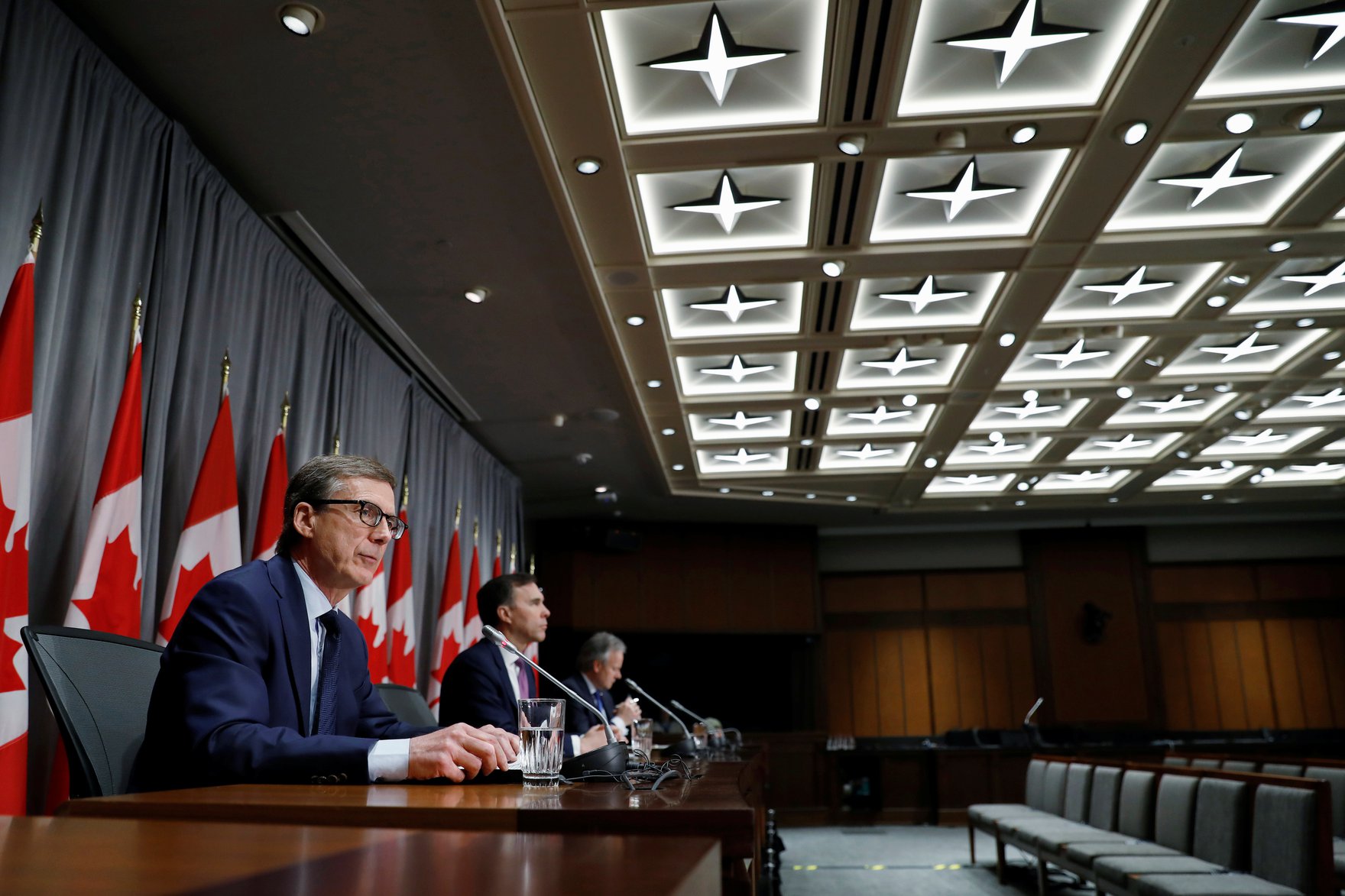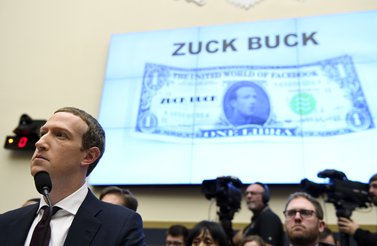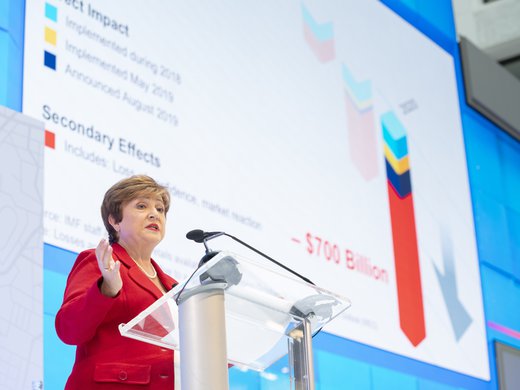The Bank of Canada’s fight against the next Great Recession began on March 4, when Governor Stephen Poloz and his five deputies cut the benchmark interest rate by half a percentage point.
A cut was expected. GDP had effectively stalled at the end of 2019. But the size of the reduction got people’s attention; the Bank of Canada, like many of its peers, favours incremental, quarter-point moves. “The COVID-19 virus is a material negative shock to the Canadian and global outlooks, and monetary and fiscal authorities are responding,” officials said in their revised policy statement, foreshadowing a dramatic series of events that will be discussed for years.
Canada’s monetary authority would respond again nine days later with a second half-point cut, a surprise move outside the central bank’s schedule of eight annual announcements dates. The Bank of Canada had never dropped interest so much so fast, demonstrating the gravity of the situation caused by the rapid spread of the COVID-19 virus through Europe and North America.
On March 27, the Bank of Canada sprung a second off-schedule half-point cut, dropping the benchmark rate to 0.25 percent, which is as low as the central bank thinks it can go without upsetting the proper functioning of financial markets. Officials also said they would begin creating money to purchase tens of billions of dollars’ worth of government bonds and commercial paper, an aggressive strategy that had never been tried in Canada. They put no limit on the plan, other than to say they would be pushing cash into the financial system until the “economic recovery is well underway.”
In the middle of all those historic announcements came another, somewhat curious, statement.
“During this time of heightened public health measures intended to limit the transmission of COVID-19, some consumers and businesses are choosing not to use cash to limit potential exposure,” the Bank of Canada said in a press release on March 18 (later slightly amended). “Refusing cash could put an undue burden on people who depend on cash as a means of payment. The bank strongly advocates that retailers continue to accept cash to ensure Canadians can have access to the goods and services they need.”
The intervention appears to be an afterthought, given the magnitude of the Bank of Canada’s other announcements. It’s noteworthy that with everything else that was going on, the central bank felt it had an obligation to try to keep cash circulating. The press release was a reminder that policy makers are stewards of the payment system, something most of us take for granted.
It shows that the Bank of Canada was correct to start laying the ground for a central bank digital currency, or CBDC.
“Refusing cash could put an undue burden on people who depend on cash as a means of payment. The bank strongly advocates that retailers continue to accept cash to ensure Canadians can have access to the goods and services they need.”
In February, Timothy Lane, a deputy governor, gave a speech in Montreal. It didn’t garner many headlines, but it was significant. Lane attended a financial technology (sometimes referred to as fintech) conference to give an update on the central bank’s thinking about CBDCs. He said policy makers had decided they didn’t need one at the moment, but that they would get ready to issue one in case conditions changed, a process that probably would take several years.
“At this point we have cash, and that’s used and it fulfills a purpose,” Lane said in an interview, noting too that private industry is gradually improving the efficiency and reach of the electronic payments systems. “So long as that is going the way we hope it will, we don’t really need to see a need to issue a central bank digital currency. It’s more a sense that things might, despite our best efforts, turn out differently than we expect.”
COVID-19 wasn’t a variable back in February, but it could trigger one of the conditions that the Bank of Canada said could force it to issue a CBDC. In a background paper explaining its position, the central bank said it could be forced to issue a digital currency if the shift to a cashless economy continued, a trend that would be “reinforced” if “significant numbers of merchants were to refuse to accept bank notes.”
That was barely three months ago. Sometimes, the future comes fast.
“If cash is not generally accepted as a means of payment, this could open a “payments divide” between those with access to digital payments and those without. This in turn could have an especially severe impact on unbanked and older consumers,” economists with the Bank for International Settlements observed in a report on April 3. “This could remain an important debate going forward, potentially asking for a strengthening of the role of cash,” the report’s authors continued. “Resilient and accessible central bank operated payment infrastructures could quickly become more prominent, including retail central bank digital currencies.”
A Rush Away from Cash
Central banks are mostly seen as arbiters of borrowing costs, and guardians of price stability. Their leaders are public figures, and their staffs generate benchmark forecasts and important economic research. They are heroes to many for doing whatever it takes to keep economies from melting down, and villains to those who don’t like that unelected technocrats have so much power.
But apart from all that drama, central bankers are plumbers, charged with making sure that money can circulate. They take that aspect of their job seriously. Tiff Macklem, who will take over as governor of the Bank of Canada on June 3, could have said anything he wanted at the press conference at which Finance Minister Bill Morneau announced his choice to replace Poloz. Macklem chose to use part of his opening statement to emphasize his commitment to the central bank’s “four core functions,” one of which he described as the “provision of secure, reliable bank notes.” (The other three, in Macklem’s words, are the “independent conduct of monetary policy,” the “promotion of a safe and efficient financial system” and “by providing banking services to the Government of Canada.”)
So, in keeping with its role of plumber, the Bank of Canada was compelled in mid March to take a break from fighting one of the most severe recessions in history to nudge shop owners to accept coins and bills. Still, the Bank of Canada’s intervention appears to have had little impact on public perceptions.
Relatively early in the COVID-19 crisis, Quebec’s government, for example, advised retailers to stop accepting cash so as to slow the spread of the virus, which made it impossible to purchase beer or wine at the government-owned Société des alcools du Québec without a debit or credit card. A week later, Montreal’s transit authority said it would no longer accept cash, meaning that anyone without a bank account was effectively barred from using public transportation.
On April 13, the central bank updated and reissued its March request to retailers, this time including a statement from Isaac Bogoch, an infectious disease physician and scientist at the Toronto General Hospital Research Institute, who asked retailers and service providers to think of potential customers whose only payment option is coins and cash. “We know that SARS-CoV-2 (COVID-19) can stick to surfaces for a few hours to a few days, and this may include hard currency,” Bogoch said. “Still, we can find ways to ensure that all Canadians have access to essential goods and services, even if they are using cash.” For its part, the Bank of Canada advised that it is “possible to clean polymer bank notes with a bit of soap and water since they are resistant to moisture,” although it stressed that “this is not the case for older paper notes.”
Last year, some speculated that central banks would counter Facebook’s proposed digital currency, Libra, with digital currencies of their own. “Facebook’s developing Libra cryptocurrency no doubt served as a catalyst for a timely reconsideration of the risks posed by private-sector competition,” John D. Murray, a former Bank of Canada deputy governor, now an adjunct professor of economics at Queen’s University in Kingston, Ontario, wrote in a memo for the C. D. Howe Institute in January. Unlike bitcoin, which has more in common with gold than money, a digital currency designed for Facebook’s network of more than two billion users could plausibly challenge government tender. Libra would be an attractive way to move money around the world because current systems are slow and relatively expensive. If it became too popular, however, central banks could struggle to conduct monetary policy, because less commerce would be conducted in national currencies.
“While earlier concerns centred largely on the declining use of banknotes and what this might imply for government seigniorage, central bank worries are now more existential and focused on the future role of central banks themselves,” Murray said in the memo.
Reconsideration was paired with pushback. The Federal Reserve in the United States, the Bank of England and other regulators made it clear that they had deep concerns about what Facebook was trying to do. It became obvious that meeting Libra’s original timelines would mean courting confrontation with some of the world’s most powerful governments, and many of Facebook’s partners dropped out.
“While earlier concerns centred largely on the declining use of banknotes and what this might imply for government seigniorage, central bank worries are now more existential and focused on the future role of central banks themselves.”
Still, Facebook refused to pull the plug, insisting its intentions for Libra were misunderstood. Then, on February 21, the effort got a shot in the arm: Shopify, which designs software for e-commerce websites and is one of Canada’s biggest publicly traded companies, announced it had joined the Libra Association, the independent group that oversees the project.
“As online commerce becomes increasingly borderless, it’s easy to forget that payments and the value exchange of goods are not a solved problem everywhere,” Shopify stated in its company news. “Our mission has always been to support the entrepreneurial journey of the more than one million merchants on our platform,” the company added. “That means advocating for transparent fees and easy access to capital, and ensuring the security and privacy of our merchants’ customer data. We want to create an infrastructure that empowers more entrepreneurs around the world.”
The Libra Association isn’t pushing its luck, however. In April, it scaled down its ambitions, announcing that it would issue coins backed by various sovereign currencies rather than a single floating currency. The competitive challenge that most worried Lane in February remains, but it has mellowed.
Instead, the existential threat now appears to be a rush away from cash, triggered by a widely held belief that bills and coins could carry the virus that causes COVID-19.
As economies reopen, many businesses are warning customers that they won’t accept cash, even though the World Health Organization says handling cash poses little risk. The narrative of “dirty money” could be too powerful to overcome, especially considering there isn’t a uniform view. While the Bank of Canada was urging retailers to accept cash, Valdis Dombrovskis, European Commission vice-president for financial services, tweeted that it was “time to swap your coins for payment cards — safer for containing #Coronavirus.”
Advocates of financial technology see an opening to wrest the advantage from legacy finance.
“For the past five weeks I have not touched a single coin or banknote, instead relying exclusively on electronic payments systems and credit cards that only I touch,” Gary Cohn, formerly US President Donald Trump’s top economic adviser and the second-highest-ranking executive at Wall Street investment bank Goldman Sachs, wrote in an op-ed published in The Financial Times on April 29. “The slow rise of digital currency has been given a gigantic boost by the pandemic,” added Cohn, who acknowledged that he was an investor in some fintech companies. “The shift will be disruptive but is clearly a leap in the right direction.”
Who Can Participate in a Digital Economy?
Ideas about money and payments are prone to misconception, even by experts.
In January, Avery Shenfeld, chief economist at CIBC World Markets, the investment banking arm of one of Canada’s largest financial institutions, dismissed all the fuss over CBDCs, telling an audience assembled by the Economic Club of Canada on January 8 that Canada already had a digital currency, “the Canadian dollar.” Shenfeld reasoned that since he could purchase most things with a bank card, traditional currencies such as the Canadian dollar and the euro already were essentially digital.
Shenfeld’s description assumes everyone has a bank account or, for that matter, easy access to a bank branch. The Bank of Canada, which considers the monetary system a public good, makes no such assumption.
“Access to money is essential for participation in the economy and must therefore be available to everyone,” the central bank said in its February backgrounder on CBDC. Cash is the only means of payment and store of value available to individuals outside the formal banking system. A CBDC would be denominated in Canadian dollars, but it would have to replace all the positive attributes of physical cash, according to the Bank of Canada.
“Digital currencies are designed to provide the same benefits as cash — safety, universal access, resilience, privacy and competition — but in an electronic format that could be used for online transactions or at the point of sale, using a mobile phone or a special card or device,” Lane said in his Montreal speech. “It would be truly equivalent to cash.”
If digital upstarts can support cashless payments, then the central bank can too. Canadian policy makers are studying two methods: a “value-based” approach that would involve creating universal technology that would allow Canadians to transfer cash to their phones or a card, and an “account-based” approach that would see the central bank host deposits from individuals. The latter would be the surest way to guarantee access, since there would be no financial barriers to obtaining a deposit account; however, it could also pull money out of the banking system, which would put upward pressure on interest rates and thus choke investment. That’s why if the Bank of Canada ever took deposits from individuals, it probably would not offer interest.
In his interview with me in February, Lane said that policy makers would need “years, not months” to work out all the technical issues. An additional complication would be the need for at least some international coordination, as the emergence of one or a few CBDCs could pose the same threat to laggards as Libra.
“The position it would put us in would be very similar to emerging market developing countries that are dollarized,” said Lane, referring to countries that adopt another’s (traditional) currency. “If we were to go down a similar route, we’d have a similar set of issues to what they’ve had, which is we would basically lose control of the relevant measure of price stability in Canada and the ability to control financial stability in Canada. Based on our current mandate, that would be unacceptable.”
Unfortunately, international coordination had already deteriorated during Donald Trump’s presidency, and COVID-19 has put additional strains on global governance. The Group of Twenty has struggled to work together to arrest a pandemic. It’s difficult to imagine digital currencies are on anyone’s priority list right now.
“It’s on the agenda,” Lane said of CBDCs back in February, “but nevertheless, it still isn’t moving fast enough for many people.”
If international discussions about what to do about digital currencies were moving too slow at the start of the year, they probably will be moving even slower now, as issues related to fighting COVID-19 will have pushed their way to the top of every government’s to-do list. But maybe Macklem can make the case that CBDCs belong there too. After all, the disease is speeding up the shift to a cashless society. That means the issue is more urgent than it was a year ago, not less so.




